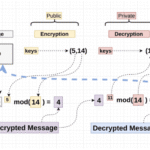Have you ever pondered how secretive communications can remain hidden from prying eyes? In a world increasingly characterized by digital interactions, the challenge of encrypting text cannot be understated. In this guide, we shall unravel the complexities of text encryption using Python, a versatile programming language that has become an invaluable tool for developers and security professionals alike.
Encryption, in its essence, is the process of converting plain text into a coded format, rendering it unreadable without a decryption key. But why is this process so important? With data breaches and privacy invasions becoming alarmingly commonplace, the art of encrypting information has surged into prominence. Individuals, corporations, and governments must take steps to safeguard sensitive data. Thus, the question arises: how can we implement basic encryption techniques using Python?
Before diving into Python’s practical implementations, it is prudent to familiarize ourselves with fundamental concepts related to encryption. At its core, encryption employs algorithms to obfuscate plain text. There are two predominant types of encryption: symmetric and asymmetric. Symmetric encryption uses a single key for both encryption and decryption, while asymmetric encryption relies on a pair of keys—a public key for encryption and a private key for decryption.
Let us first explore symmetric encryption, which is simpler and faster. One of the most widely used libraries for cryptography in Python is the `cryptography` library. This library provides both high-level recipes and low-level interfaces for common cryptographic algorithms. To begin, install this library via pip:
pip install cryptographyAfter installation, you can utilize the library to perform symmetric encryption. A quintessential algorithm involved in symmetric encryption is the Advanced Encryption Standard (AES). To implement AES encryption, we need to generate a secret key. However, it’s essential to ensure that this key is securely stored and managed to maintain data integrity. Here is a concise example of encrypting text using AES:
from cryptography.fernet import Fernet
# Generate a key
key = Fernet.generate_key()
cipher_suite = Fernet(key)
# Encrypting a message
plaintext = b"This is a secret message."
ciphertext = cipher_suite.encrypt(plaintext)
# Decrypting the message
decrypted_text = cipher_suite.decrypt(ciphertext)
print("Ciphertext:", ciphertext)
print("Decrypted text:", decrypted_text)In this snippet, we generate a key with the `Fernet` class, encrypt a byte string message, and then decrypt that message back to its original form. This simple implementation demonstrates the core functionality of symmetric encryption. But, one might ask, what measures can individuals take to further enhance the security of their systems? The savvy coder must consider multiple facets of security, such as key management and data integrity checks.
Next, we transition to asymmetric encryption, also known as public-key cryptography. This method is essential for secure communication over the Internet, especially during transactions and private exchanges. The `pycryptodome` library allows for easy implementation of RSA encryption, a commonly utilized asymmetric algorithm. First, install the library:
pip install pycryptodomeAfter installation, we can generate a pair of public and private keys. The public key can be shared openly, while the private key must be kept secret. Here’s how you can generate keys and use them for encryption and decryption:
from Crypto.PublicKey import RSA
from Crypto.Cipher import PKCS1_OAEP
from Crypto.Random import get_random_bytes
# Generate a pair of keys
key = RSA.generate(2048)
private_key = key.export_key()
public_key = key.publickey().export_key()
# Encrypting with the public key
cipher = PKCS1_OAEP.new(RSA.import_key(public_key))
message = b"Message to be encrypted"
ciphertext = cipher.encrypt(message)
# Decrypting with the private key
cipher = PKCS1_OAEP.new(RSA.import_key(private_key))
decrypted_message = cipher.decrypt(ciphertext)
print("Ciphertext:", ciphertext)
print("Decrypted message:", decrypted_message)This code snippet illustrates the generation of an RSA key pair, along with the encryption and decryption process. It is advisable to use well-established libraries to avoid common pitfalls associated with cryptography. Utilizing them allows one to focus on the implementation rather than the intricacies of cryptographic algorithms.
However, accomplishing encryption is merely one facet of a larger digital security framework. One must also contemplate the various attack vectors that threat actors could exploit. Implementing encryption protocols requires a thorough understanding of potential vulnerabilities, such as improper key management, outdated algorithms, and social engineering tactics aimed at retrieving sensitive information. Staying abreast of best practices in cryptography and adopting a proactive stance to security can mitigate many risks.
In conclusion, mastering the art of text encryption using Python is an essential skill for safeguarding digital communications. As technology evolves, so too does the landscape of secure communication. Whether one is encrypting messages for personal use, securing data for a business, or facilitating online transactions, understanding the underlying principles of cryptography empowers individuals to take responsibility for their digital privacy.
Ultimately, as we navigate this complex web of digital interactions, encryption serves as a formidable ally, providing peace of mind in an age where confidentiality and security are paramount. So, what’s your next move? Are you prepared to adopt these encryption methodologies to fortify your own communications?









Leave a Comment